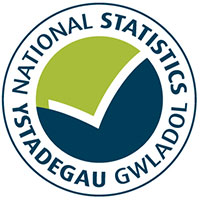The mid-year estimates refer to the population on 30 June of the reference year and are published annually.
This is not the latest release in the series: Mid year estimates of the population
They are the official set of population estimates for the UK and its constituent countries, including local authorities in Wales and their equivalents in other countries.
This headline is based on the mid-2021 population estimates for the UK, Wales, England, Scotland, and Northern Ireland published by the Office for National Statistics (ONS).
For Wales, England, and Northern Ireland, these are the first population estimates to be based on the 2021 censuses for these countries. For Scotland, the census was moved to 2022 (due to the impact of the COVID-19 pandemic) with the mid-2021 population estimates being rolled forward from mid-2020 using the standard method.
Main points
- On 30 June 2021 there were estimated to be around 3,105,000 people living in Wales, an increase of 1.4% since mid-2011 (around 42,000 more people).
- People aged 65 years or older were estimated to account for just over a fifth of the total population in Wales in mid-2021, the highest proportion of all UK countries (21.4% in Wales, or 666,000 people). This is higher than in mid-2011, when 18.5% of the population were aged 65 years or older (566,000 people).
- 60.9% of the population were aged 16 to 64 years in mid-2021 (around 1,893,000 people). This is lower than in mid-2011, when 63.4% of the population were aged 16 to 64 years (around 1,942,000 people).
- Children and young people aged 0 to 15 years old accounted for the remaining 17.6% of the population in mid-2021 (547,000 children and young people). This is also lower than in mid-2011, when 18.1% of the population were aged 0 to 15 years old (around 556,000 children and young people).
- The population is estimated to have increased in the majority of local authorities between mid-2011 and mid-2021, with the largest increases in Newport (9.5% increase), Vale of Glamorgan and Bridgend (4.6% increase in both areas).
- The population is estimated to have decreased in seven of the 22 local authorities between mid-2011 and mid-2021, with the largest decreases in Ceredigion (6.2% decrease), Blaenau Gwent (4.0% decrease) and Gwynedd (3.7% decrease).
Census 2021
The mid-2021 population estimates are primarily based on the 2021 censuses (for Wales, England, and Northern Ireland). The usual resident population as at Census Day (21 March 2021), by single year of age, is aged on to 30 June and then flows are applied to adjust for births, deaths and net migration.
Census 2021 estimated that the population of Wales was around 3,107,500 on Census Day, 21 March 2021. The population of Wales is estimated to have decreased slightly in the period between Census Day (21 March) and 30 June, by around 2,000 people. This is due to negative natural change (fewer births than deaths), and negative net migration (more people moving out of Wales than moving into Wales). Negative net internal migration (more people moving out of Wales to other parts of the UK than moving in) between Census Day and 30 June is partly due to students and graduates moving from term time addresses to non-term time addresses during this period. However, patterns of population change in this period may also reflect some impacts related to the pandemic, as many of the restrictions in place at Census Day had been lifted by 30 June 2021.
The ONS has stated that the mid-year estimates for the UK will be revised in the next two years to include updated population estimates for Scotland, incorporating the 2022 census for Scotland, as well as revisions to international migration data as part of their transformation of population and migration statistics.
Note
As agreed with the Office for Statistics Regulation, these statistics will be updated at 12.30pm on the day of release by ONS. StatsWales tables will follow in due course.
Contact
Stephanie Harries
Email: stats.popcensus@gov.wales
Rydym yn croesawu gohebiaeth yn Gymraeg / We welcome correspondence in Welsh.

